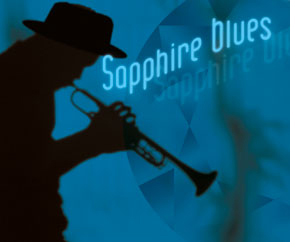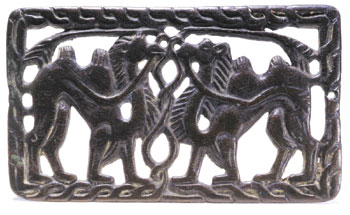Sapphires Take
Center Stage
The 2004 Carnegie Gem & Mineral
Show
 Friday, November
19 through Sunday, November 21 Friday, November
19 through Sunday, November 21
Sapphire
is synonymous with the color blue, and you can
easily picture sapphire seas. But a sapphire
is beautiful even beyond the color blue, and comes
in every color but red. The seventh annual Carnegie
Gem & Mineral Show will focus on this gorgeous
gemstone and bring together some of America’s
top lapidary artists, retail vendors, and jewelers
in one of the finest gem and mineral shows in the
United States. There will be pieces for sale for
all types of collectors, information for less experienced
enthusiasts, and activities for the entire family.
It’s also a great place to do some holiday
shopping.
This year’s show is being presented
by Bailey Banks & Biddle and PNC Advisors
and will feature a “Showcase Suite” that
will include—among
other beautiful things—a 25.44-carat pink
sapphire and “Big Blue,” a 126.43-carat
blue sapphire valued at approximately $170,000.
Following the show,
the pink sapphire will be donated to Carnegie
Museum of Natural History’s Hillman
Hall of Gems and Minerals.
The annual Benefit Mineral
Auction will be held
on Saturday, November 20, at 7 p.m. It will
feature specimens from the collections of the Houston
Museum of Natural Science, the Seaman Mineralogical
Collection,
the Harvard Mineralogical Museum, and Carnegie
Museum
of Natural History.
 A
Treasure’s
Trove A
Treasure’s
Trove
Another highlight
of the show is A Treasure’s
Trove, an enchanting fairy tale that will kick off
a national treasure hunt when it is published on November
15. Author Michael Stadther spent eight years writing
and illustrating a dramatic story about 12 forest creatures
who join forces with Zac, a handsome woodcarver, his
beautiful half-elf/half-human wife, Ana, and their
dog Pook, against the evil Rusful to save a dying forest
and all the creatures that live there. The book has
a strong environmental theme and teaches the power
of friendship, loyalty, and love.
Throughout the book, Stadther has cleverly included
clues leading to the book’s treasure—12
magnificent jewels created especially for the hunt
with a combined value of $1 million. Each one-of-a-kind
jewel is based on one of the 12 forest characters in
the fairy tale. In order to claim a jewel, someone
must find one of 12 18-carat gold tokens that Stadther
has hidden in 12 separate locations throughout the
continental United States.
“The tokens aren’t located in
caves; they’re
not under water, nor are they on mountaintops or
on private property,” says Stadther, “Nothing
has to be moved or lifted to find them. They’re
all hidden in places accessible to everyone.” He
also emphasizes that the clues leading to the jewels
do not require special knowledge to be deciphered. “Anyone
who can read can discover the exact location of each
treasure—just the way one of the characters
does in the story.”
The jewels range in value
from several thousand dollars to $450,000, and
all 12 pieces will be on display
throughout the Carnegie Gem & Mineral Show.
Author Michael Stadther will attend the show to
sign copies
of his
book, which will be available for purchase with
a companion kit for $29.95.
The 2004 Carnegie Gem & Mineral
Show is free with general museum admission
and is being sponsored in
part by Chu Investment Counsel Inc., The Henry
L. Hillman Foundation, Marsetta Lane Staffing,
and the Pittsburgh
Tribune-Review.
Special Gem Show Feature:
The Black Orlov Diamond
In addition to showcasing some of the finest sapphires
in the world, the Carnegie Gem & Mineral Show will
feature a rare and famous black diamond—the Black
Orlov. According to legend, the 67.5 carat, cushion-cut
diamond, also called the “Eye of Brahma” for
its association with a 19th-century shrine near Pondicherry,
India, was stolen by a monk, discovered later in
the possession of Russian Princess Nadia Vyegin-Orlov,
and sold several times on the market, most recently
for $1.5 million. The Black Orlov is mounted in a
modern
diamond-and-platinum necklace and has been exhibited
widely, including at the American Museum of Natural
History in Washington, D.C.
 Jewels and Jewels and
all that Jazz!
Carnegie Museum of Natural History invites you to attend
the Sapphire Blues Preview Gala for the Carnegie
Gem & Mineral Show on Thursday, November 18,
7-10 p.m. Last year’s gala preview party was
voted a “Top-10 Party” by the Pittsburgh
Post-Gazette, so the 2004 preview is not to be missed!
The black-tie optional evening will include live
jazz, fine food, drinks, dessert, and a sneak peek
at the gorgeous sapphires that will be featured in
the show. Tickets are $125 per person and can be
purchased by calling 412.578.2479.
UPCOMING
LECTURES November 13
Early Horse Herders on the Asian Steppe
Dr. Sandra Olsen, Section of Anthropology
CMA Theater, 1 p.m. Free.
Dr. Olsen has spent over 12 years investigating some
of the world’s first horse herders’ settlements.
Her collaboration with Kazakh and other American archaeologists
has led to exciting new information on how horses were
first domesticated. Her latest findings will be shared
during this presentation.
Also November 13
Nomads of the Northern Frontier: The People Behind
the Bronzes
Katheryn Linduff, Professor of Anthropology and Art
History,
University of Pittsburgh
Carnegie Museum of Art Theater, 1 p.m. Free.
Archaeological investigation during the past two decades
in northern China reveals a textured picture of the
nomadic ways of life that existed there in the Bronze
and Iron Ages. The artifacts on exhibit show the artistic
traditions of these myriad groups, but knowledge is
now emerging of their pastoral adaptation to the steppe,
their political organization, and their mixed relationships
with neighboring peoples.
December 4
The Soul of Kazakhstan
Wayne Eastep, Professional Photographer
Carnegie Lecture Hall, 1 p.m. Free.
This is a land of women warrior chiefs, the place where
people first domesticated horses, where the apple originated,
and the start of the famous Silk Road. Photographer,
adventurer, and world traveler Wayne Eastep will present
his photographs and talk about the culture, history
and people of Kazakhstan, an important and unique country
in Central Asia. A book signing will follow the lecture.
Dine with the Dinosaurs Lecture Series
Enjoy a sumptuous dinner among the denizens of Dinosaur
Hall.
Learn intriguing information about the history of the
Museum of Natural History’s dinosaur collection,
the exhibit hall, ongoing research, and plans for the
exciting transformation of Carnegie's dinosaurs. The
evening’s agenda includes cocktails at 6 p.m.,
dinner at 7 p.m., and a lecture at 8 p.m.
Fee: Members: $100 per event, Non-members: $125 per
event. Company tables may be purchased. Call for details.
To register, call 412. 578.2479.
November 10 - Dr. Zhexi Luo, Curator
Dr. Luo was part of the international team of scientists
who discovered Sinodelphys szalayi, the most primitive
and oldest known relative of all marsupial mammals
that lived at the same time as the dinosaurs.
December 2 - Dr. David Berman, Curator
Dr. Berman has searched the American Southwest and
Germany for evidence that Earth's landmasses were
once joined as a single continent, culminating in
the discovery of similar fossils and geologic material
on continents that, today, are oceans apart.
A New Book
The Hunt for the Dawn Monkey
Chris Beard unearths
the origins of monkeys, apes, and humans.
"This could be the ultimate book on our origins.
For the first time, Chris Beard sheds light on a hitherto
little-known yet highly controversial area of paleontology—the
search for the ancestry of monkeys, apes, and, ultimately,
humans," says Henry Gee, author of In Search
of Deep Time.
Beard’s new book, The Hunt for the
Dawn Monkey, is scheduled for publication by the
University of California
Press in December 2004. He is the Museum of Natural
History’s curator and head of the Section of
Vertebrate Paleontology, and a past winner of a MacArthur "genius" grant.
In this book, he is joined by his colleague, Museum
Illustrator Mark Klingler, in revealing “the
dawn of recent life.”
 The search for primate
fossils takes readers back roughly 45 million years
into the Eocene Period,
where they
discover a tantalizing new perspective on man’s
deepest evolutionary roots. In a fast-paced narrative
full of vivid stories from the field, Beard reconstructs
man’s extended family tree, showing that
the first anthropoids—the diverse and successful
group that includes monkeys, apes, and humans—evolved
millions of years earlier than was previously suspected
and emerged in Asia rather than Africa. The search for primate
fossils takes readers back roughly 45 million years
into the Eocene Period,
where they
discover a tantalizing new perspective on man’s
deepest evolutionary roots. In a fast-paced narrative
full of vivid stories from the field, Beard reconstructs
man’s extended family tree, showing that
the first anthropoids—the diverse and successful
group that includes monkeys, apes, and humans—evolved
millions of years earlier than was previously suspected
and emerged in Asia rather than Africa.
Part of
the story is the saga of two centuries of scientific
exploration in search of anthropoid
origins,
from the
early work of Georges Cuvier, the father of paleontology,
to the latest discoveries in Asia, Africa, and
North America's Rocky Mountains. Against this
historical backdrop, Beard weaves the story of how
his own
expeditions
have unearthed crucial fossils—including
the controversial primate Eosimias—that
support his compelling new vision of anthropoid
evolution.
In the only book written for a wide
audience
that explores this remote phase of humankind’s
evolutionary history, The Hunt for the
Dawn Monkey adds a fascinating
new chapter to man’s understanding of
humanity's relationship to the rest of life
on earth. A Lecture and Book-signing by Author Chris Beard
Tuesday, November 9, 7 p.m.
Chris Beard discusses his research for the Hunt
for the Dawn Monkey in a free lecture in the Carnegie Museum
of Art Theater. After the lecture there will be a book
signing.
Ancient Bronzes of the Asian Grasslands
from the Arthur M. Sackler Foundation
Through January 2, 2005

The exhibition Ancient Bronzes of
the Asian Grasslands from the Arthur M. Sackler
Foundation brings to life
the complex cultures that flourished across the Asian
grasslands from northern China and Mongolia into Eastern
Europe. It shows through bronze artwork how these people
influenced and were influenced by the culture of dynastic
China, and it illustrates the important role of the
steppe dwellers in facilitating trade and travel along
the Silk Route across Asia.
 Fabulous
Sale of Alaskan Native Arts Fabulous
Sale of Alaskan Native Arts
Through centuries of subsistence living, the indigenous
peoples of Alaska have sustained an astoundingly
diverse creative heritage. Please join the Alaska
Native Arts Foundation at Carnegie Museum of
Natural History for a rare opportunity to view
and learn
about the arts of Alaska’s first peoples.
On December 11 and 12, there will be sculptures,
carvings,
containers, jewelry, and more on display and
for sale on the Third Floor Balcony and in Polar
World:
Wyckoff Hall of Polar Life.
Back to Contents |